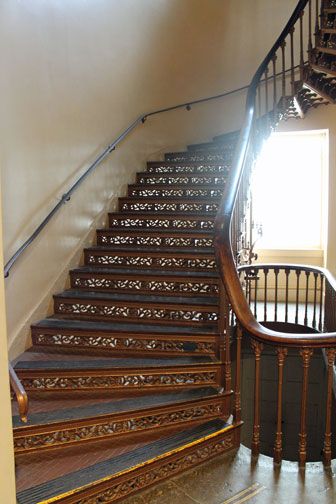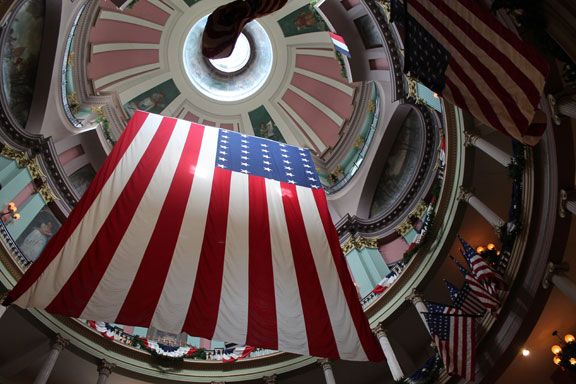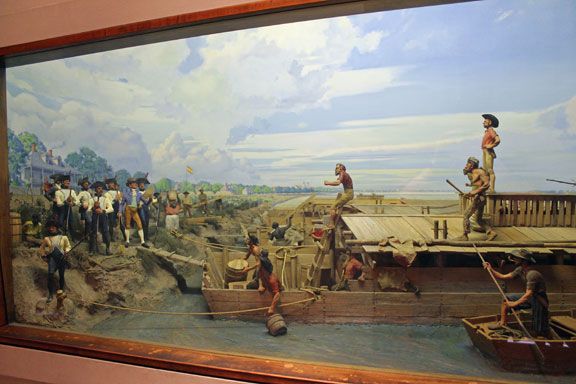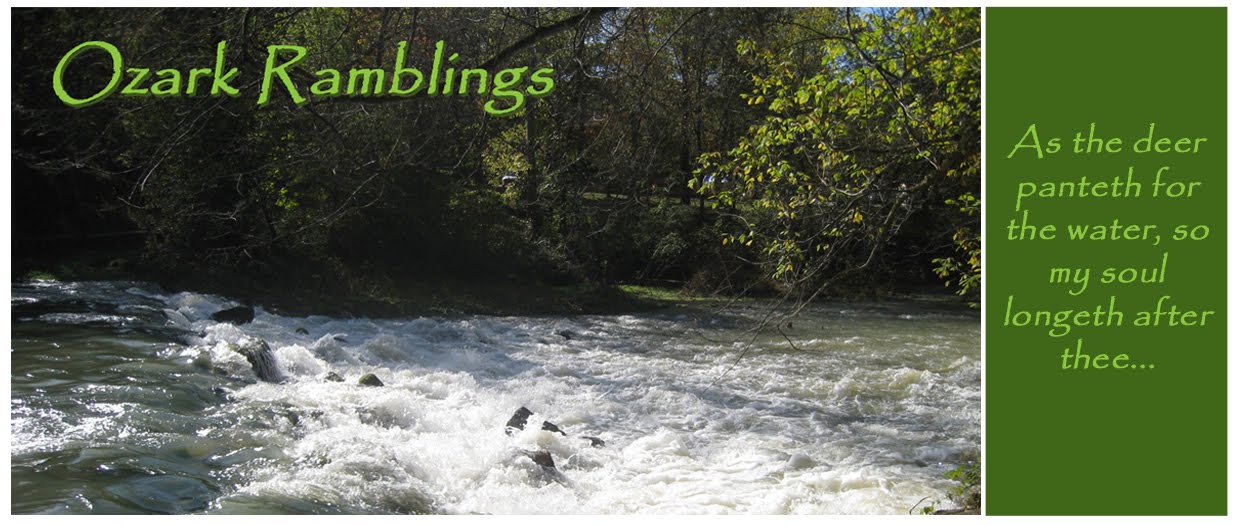 Tourists looking down from the windows of the Arch to the west often see the federal style building with the oxidized copper dome and assume it’s the state capitol. Nope, that’s in Jefferson City—not visible from the Arch. St. Louisans refer to the building as “The Old Courthouse” Not terribly original, huh? The basilica nearly across the street is referred to as the Old Cathedral. I’m not presuming this is the only old courthouse in the country, in fact I’m sure there are many older buildings on the east coast where legal cases were heard.
Tourists looking down from the windows of the Arch to the west often see the federal style building with the oxidized copper dome and assume it’s the state capitol. Nope, that’s in Jefferson City—not visible from the Arch. St. Louisans refer to the building as “The Old Courthouse” Not terribly original, huh? The basilica nearly across the street is referred to as the Old Cathedral. I’m not presuming this is the only old courthouse in the country, in fact I’m sure there are many older buildings on the east coast where legal cases were heard.
The building has ties to the founding of the city itself. The land on which it sits was donated in part by Auguste Chouteau with the stipulation that it be forever used as the site of the courthouse. (Chouteau was 14 years old when he laid out the plans for St. Louis – learn more about his story in the book A Boy for a Man’s Job). Yes, it’s not being used as a courthouse anymore and yes, the Chouteau descendants sued to have the land returned to them, but they lost and the courthouse and land was turned over to the National Parks Department where it’s now part of the Jefferson Expansion Memorial (along with the Arch ).
I hadn’t been to the Old Courthouse since my fourth grade field trip –and it’s a good thing I didn’t share what I remembered because they ripped out all those exhibits years ago. Instead, I decided to invite my mother on an “adventure” (our family term for field trips) to the big city. We took Metrolink and got off at the 8th & Pine station. If you’re already visiting the Arch, you’ll just need take a bridge over the highway. NOTE: they are in the process of making the highway go in a tunnel and creating additional parkland to better connect the Arch grounds to the rest of the city.
The first thing to impress me was the art and architecture of the building. Just look at the elaborate iron scrollwork in the steps!

And then you reach the rotunda, with a very patriotic display I might add.

We were far too early for the guided tour so we browsed on our own. Where the Museum of Westward Expansion under the Arch covers all of the Louisiana Purchase territory, the exhibits in the Old Courthouse focus on the City of St. Louis. There is the diorama room…

Here’s a keelboat is bringing in supplies. Can you see the flag in the background? It’s Spanish, as are the militiamen on shore. Spain controlled the land from 1762 to 1802 (remember I wrote about this in D is for Daniel Boone Home) The house is actually French in style, as were the original settlers of the city. There were also four galleries with photos and artifacts from four eras of St. Louis history: founding to 1850, 1850-1900, 1900-1930 (this includes the St. Louis World’s Fair, 1930 to present.

Even if you’re not interested in architecture or St. Louis history, it’s still worth visiting the Old Courthouse to learn about the significant 19th century trial that took place there. Yes, this is another example of Missouri history overlapping U.S. history---in this case the Dred Scott trial, a significant step leading to the Civil War.
 Dred Scott was a slave brought to the state by the Blow family and sold to a military surgeon, Dr. John Emerson. The doctor was assigned to various forts and outposts, including at least two in “free” land –the state of Illinois and Wisconsin Territory (remember the Missouri Compromise prohibited slavery in all Louisiana Purchase land north of 36°30′ latitude). Both Scott and the doctor married and both couples returned to St. Louis in 1842. Shortly after, the doctor died and his widow inherited the Scotts as her property. She hired out the Scotts (they did the work, but she collected most of the wages).
Dred Scott was a slave brought to the state by the Blow family and sold to a military surgeon, Dr. John Emerson. The doctor was assigned to various forts and outposts, including at least two in “free” land –the state of Illinois and Wisconsin Territory (remember the Missouri Compromise prohibited slavery in all Louisiana Purchase land north of 36°30′ latitude). Both Scott and the doctor married and both couples returned to St. Louis in 1842. Shortly after, the doctor died and his widow inherited the Scotts as her property. She hired out the Scotts (they did the work, but she collected most of the wages).
In 1846, the Scotts filed lawsuits against the widow for their freedom (according to a movie we saw in the courthouse, nearly 300 slaves obtained their freedom this way as Missouri courts supported the “once free, always free” doctrine despite being a slave state). Their first case was lost on a technicality, but they were allowed to re-file their suits. In 1850, the Circuit Court granted the Scotts their freedom, but the widow appealed to the Missouri Supreme Court. From that point on, the Scotts lost in both state and federal courts up to the Supreme Court decision in 1857. Chief Justice Taney wrote in the majority opinion that no African descendant, slave or free, could be a citizen of the United States and that the provisions of the Missouri Compromise were voided (in other words congress couldn’t prohibit slavery in the territories).
So what happened to the Scotts? Shortly after the decision, the widow sold them back to their previous owners, the Blows, for one dollar. I’ve read that she did so because she had remarried, and her Massachusetts congressman husband was opposed to slavery, but the marriage took place in 1850. Why not sell them then, or let them by their freedom (as Dred Scott had once tried to do), or just free them? And when the Blows did free Dred and Harriet Scott, the widow went to court to collect the wages they had earned for the 11 years the lawsuit was being tried (the money had been held in escrow pending the outcome)—the court gave all the money to her! Dred Scott died a year later from tuberculosis.

These are copies of the “Free Negro Bonds” for Dred and Harriet Scott. The Blow family had to put up $1000 for each. The documents lay out the rights and responsibilities required for the two to live in the state of Missouri. If the Scotts were ever deemed “a menace to society” they would lose the money.
It’s not a pretty picture of Missouri or U.S. history, but I left with a greater depth of knowledge and understanding than can be gained by the one or two sentences afforded to the case in history texts. There is no admission charged to visit the Old Courthouse.
I’m linking up with …


No comments:
Post a Comment